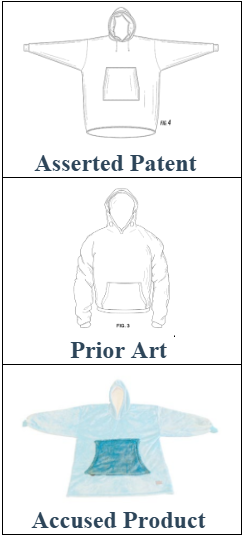
The USPTO must reject a patent application if the applicant’s claim covers what the prior art already disclosed, and patent applicants may respond to such rejections with arguments that what they claimed was different. Prosecution history disclaimer (i.e. ‘disclaimer by argument’) prohibits patent applicants from arguing to the USPTO that some feature in the prior art is different than what the applicant claimed, then later argue that an accused product infringes based on that same feature. Long recognized for utility patents, the Federal Circuit had not opined on whether arguments made to the USPTO during prosecution limit design patents (but it had held that disclaimer by amendment applies to design patents1). On July 17, the Federal Circuit held that argument in prosecution history disclaimer applies to design patents and reversed a $21 million jury verdict for infringement. The court found that Defendant Top Brand’s accused design shared features with prior art, and that those same features had been disclaimed by Cozy Comfort during prosecution to overcome a prior art rejection. Thus, the court concluded that “no reasonable factfinder could, in light of the proper claim construction” find that Top Brand’s oversized hoodie sweatshirt infringed Cozy Comfort’s U.S. Design Pat. No. D859,788.
The USPTO rejected Cozy Comfort’s patent application because the examiner believed the claimed design was similar to a prior art sweatshirt. To overcome this rejection, the patentee argued that its patented design had a differently shaped and placed pocket, among other differences. Defendant Top Brand argued that its accused product’s pocket matched features Cozy Comfort had argued were different from its patented design, and thus the patent should be construed—i.e. interpreted—not to cover the accused product. The Asserted Patent, Prior Art, and Accused Product are each shown to the right:
Cozy Comfort argued that the legal basis for doing so, prosecution history disclaimer, does not apply to arguments made to obtain a design patent because “the nature of design patents renders any purported disavowal ambiguous.” The Federal Circuit rejected this, found “no reason to distinguish between disclaimer by amendment and disclaimer by argument,” and found the differences between the Accused Product and Asserted Patent were the same as the differences Cozy Comfort had told the USPTO rendered its design different than the prior art.
This decision continues a trend of applying utility patent doctrines to design patents. The court’s delay in addressing argument-based disclaimer likely stems from the rarity of prior art rejections in design applications—until recently, only ~4% received such rejections before the Federal Circuit’s recent decision in LKQ v. GM.2 With higher scrutiny expected—particularly as the USPTO deploys AI to help research design prior art—prosecution history disclaimer will likely become more prevalent in litigation.